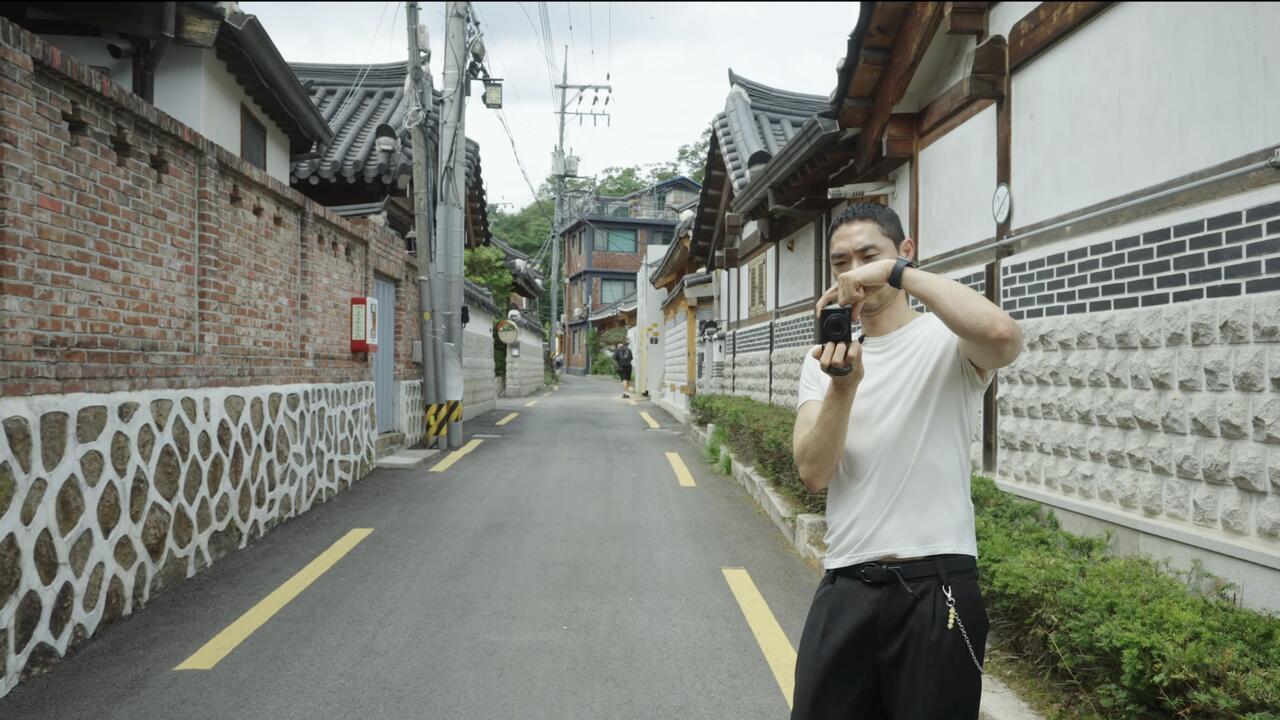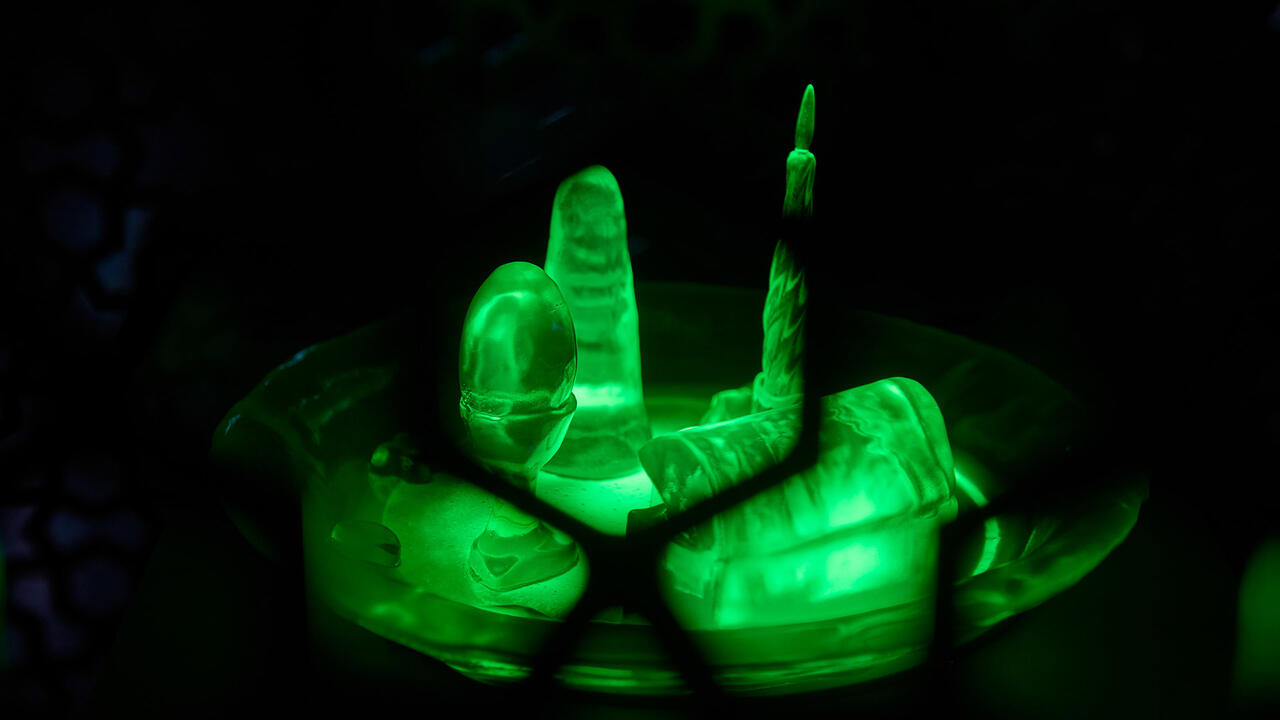Manifesta
The inaugural Manifesta in Rotterdam
The inaugural Manifesta in Rotterdam
Every day in the same room a bearded man, profoundly deaf, holds a conversation with anyone who comes along. Another artist chooses to replace the tablecloths in a restaurant with fabrics from her own country. In the streets a naked man on a leash is seen crawling on his hands and knees. All these activities have one thing in common: they are part of the inaugural Manifesta, planned as a biennial event. Manifesta gives Rotterdam a more interesting image: bombed relentlessly during World War II, it was restored with more vigour than style. More recently, it has boasted Postmodernist follies like a museum complete with an imitation moat and drawbridge. Little wonder, then, that a backlash is under way, and that questions of sheer usefulness are being broached. 'If there is to be a new urbanism, it will be based on the two fantasies of order and omnipotence; it will no longer be concerned with the arrangement of more or less permanent objects but the irrigation of territories with potential; it will no longer aim for stable configurations but for the creation of enabling fields that accommodate processes that refuse to be crystallised into definitive form; it will no longer be about meticulous definition, the imposition of limits, but about discovering unnameable hybrids; it will no longer be obsessed with the city but with the manipulation of infrastructure for endless intensifications and diversions, shortcuts and redistributions - the reinvention of psychological space.' 1
The reinvention of psychological space, it seems, has less to do with establishing new structures than with revising the uses of older ones. (A good example is Douglas Gordon and Rirkrit Tiravanija's collaboration, Cinéma Liberté (all works 1996), showing only films censored by the Dutch authorities. Another is Rietveld's Café de Unie, which for the duration of Manifesta has become an information centre and a headquarters.) The aim is to take received ideas and release them from their moorings - 'to alter the general mentality over time', as the catalogue announces - one reason, perhaps, why the five curators (Rosa Martínez, Viktor Misiano, Kataliu Néray, Hans-Ulrich Obrist and Andrew Renton) chose to make unanimous decisions on every aspect of the event. The element of revision might have been one reason why, unexpectedly, part of the work they chose is shown at what used to be called the Museum Boymans van Beuningen, now altered permanently to its new spelling 'Boijmans'. There visitors to Manifesta can enjoy themselves in the huge 'Raid the Icebox' experiment upstairs, for which Hans Haacke was asked to choose anything from the collection and show much of it without labels. Was that planned as part of Manifesta or not? The answer seems deliberately vague. Since the points at which Manifesta begins and ends are unclear, the entire concept of the event depends on a principle of quiet revolution, less to do with politics than with people, work and time.
Of the themes chosen, probably the most important is migration. 'We have no intention of altering the art world', the curators admit in the accompanying catalogue. Instead, their self-avowed intention is to destabilise our perceptions of Europe over a long period, during which time the idea of a Europe without borders will have come into existence - an important point, for Rotterdam remains the biggest port in the world. A powerful comment on this subject comes from Hale Tenger from Turkey, whose image appears on both sides of a screen in a large, darkened space. On one side the back of her body is visible, on the other the front. From time to time the image reverses, as she continues to recount her difficulties in trying to apply for a visa to leave the country. After a while her even tone comes to seem tragic. Seldom has frustration been registered as literally and rarely has execution suited subject matter so perfectly, recalling every aspect of passport offices: their impersonality, their heartbreaking matter-of-factness, most of all the total control their employees seem to wield over the destiny of others. As more reversals take place and the sense of imprisonment heightens, the speaker seems to adopt the identity of persecuted and persecutor by turns. Frightening in its sheer ordinariness, the installation confirms the importance of the right to cross boundaries.
The theme of identity is also inescapable. From Bucharest, subREAL present Data Corridor, based on an archive which began in 1935 and was continued through the Ceaucescu regime. For Manifesta, the Corridor became a room with thousands of loose photographs, a bell and an introduction by name for each imaginary visitor, a grave and a calling-card combined. On a similar theme, 'I Want to Live Like Common People' at the Chabot Museum presents photographic portraits. Metta Tronvall's women and daughters evince openness and its opposite; the older the women, the more suspicious of cameras they become. Jitka Hanslova's country scenes are wholesome, celebratory: washing on a line; skis stuck into snow; meat roasting. In contrast, Esko Männikö's bumpkins wear paper hats in what resembled a workroom/ lounge/loft. Or, indeed, a bedroom or living-room; the space of confirmed bachelorhood, where a broken fishing-rod is as liable to be lying about as a group of friends clutching bottles and wearing red paper hats. The kitsch frames are the last straw, but disliking them is futile; 'home' is not a place but rather a pact with yourself. Only Dickens or Huysmans rival Mannikö's sets, and his characters who do not need to be understood, hence their mixture of complete nonchalance and utter self-absorption.
'Home' is also one of the themes chosen by the curators, the others being 'Two Breeding Flowers Will Never Breed the Same', on the subject of nature and culture; 'Declining and Becoming', ('The idea of "rising and falling", "declining and becoming" is a metaphor for the disappearance of logocentric thought as described by Gilles Deleuze', the six-page handout guide explains, 'Now replaced in the West by the notion of "experience", a non-fixed condition of intensity which is subject to change'.); 'Grounded' (cities without centres); 'I Want to Live like Common People' (ideas of normality); 'In Every Dream Home a Heartache' (the symbolism of the house); 'Oij' (the role of the museum); 'The Laboratory for Comparative Studies' (the task of translation); 'The Institute for the Unstable Media' (the role of art); 'Migrations' (travelling); 'Time Share' (the perception of objects)... The plethora of titles suggests a network of subjects which defines everyday life, particularly its links with the mundane - laws, habits, ways of surviving, rather than (say) religion, beauty, truth. There are also connections between travel, communication and translation, changing borders and the new perception of the alignment of world powers; in other words, the 'truth' we perceive will have arisen from reading between the lines, between facts and fixity.
Collaboration is one model for the future provided by Manifesta. For example, building homes for visitors is the business of the group Ne(s)twork, with a project called My House/Your Home. Local artists construct special rooms, all different, for visiting artists. For the duration of their stay they exchange information, hold discussions, show films and attend parties and meetings. As if intent on doing the opposite, Liesbeth Bik, Peter Fillingham and Jos van de Pol's Bookshop Piece at the Museum Boijmans consists of listing the books available in the ICA bookshop in London, adding titles, then turning it into a shop. And, the artists add, 'a sculpture': a working system, designed to reply to The Kitchen Piece, a mirror image of Jos van de Pol's kitchen shown in London last year. In Rotterdam, however, questions of hierarchy, availability, temporality, copying and use are raised. The Bookshop Piece is best described as a homage.
In the Museum Boijmans itself, Dimitri Gutov acts as a guide, explaining the relevance of Breughel and van Eyck before proceeding to the Bruce Nauman rooms which, he explains, are not modern at all. Meanwhile, Vadim Fishkin sends his heartbeat around the world or relays it in the form of a pulsing bulb on a wall on the outside of the museum. In the small garden of the museum, Didier Trenet shows his Équilibre thermostatique des motivations, in which a bright yellow hosepipe twists and curls elegantly around the bronze statue of a voluptuous nude - Trenet's 'mistress' - and douses her regularly with water which slithers down her body, accompanied by erotic poetry. Meanwhile, Koo Jeung displays her Beautiful Waste Bin, which she sees as a summary of the constant action of gathering and dispersal. René Kool uses surveillance techniques to record a man in his underwear conducting to unheard music on one floor of a building and a girl dancing alone on another, a reference to an alleged bribery scandal in the Rotterdam news. Much of this work seems slight, particularly in the formal context of a famous museum.
But not all the exhibits are so flimsy. Deaf from an early age, Joseph Grigely sits in a sunny room, prepared to talk to anyone. The result is communication problematised in an inspiring way. Like a journey in the course of which the traveller has to change different modes of transport, the talk is punctuated by spells of writing, mime and drawing. An enthusiastic interlocutor, Grigely engages directly with his talking partners and requires a high degree of attention from them. Sometimes Manifesta warranted this attention. After seeing his video installation it was hard not to want to hug Jaan Toomik from Estonia, unhappy because he was sailing home. 'Everything seemed so depressing but then after a time I felt the sound of the motor of the boat. It seemed like a heartbeat... I began to dance to the sound and all my depressing feelings disappeared...' Or Nedko Solakov from Bulgaria in a video made with his wife and children, in which he turns into a snowflake, not an easy role for a large, bearded man. Or Uri Tzaig's painting of the words Nothing is Wrong, hung next to Hendrik Plenge Jacobson's painting of the words Everything is Wrong. Impossible too not to wonder about the role of the Police Gallery, which seemed to be exhibiting a sculpture consisting of a police van with a broken window. Or, indeed, about that naked Russian, campaigning for animal rights. But perhaps there were just too many puzzles. Manifesta lacked clarity; had a confusing catalogue; included too many interventions and abused the museum setting. Nevertheless, on the level of sheer personal exchange, it may have succeeded well enough to make its rivals reconsider their own tactics.
1. Rem Koolhaas & Bruce Mau S,M,L,XL New York: Monacelli Press 1995, 969, quoted by Martin Beck in Offer, a poster he designed for Manifesta.

















